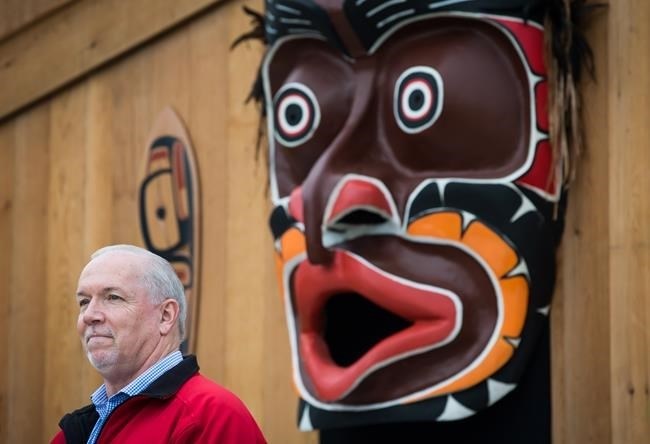
B.C. Premier John Horgan listens as a large First Nations carving of a mask is displayed during a ceremony before the raising of a replica Haida totem pole on the traditional territory of the Semiahmoo First Nation, at the Douglas-Peace Arch border crossing, in Surrey, B.C., on Friday September 21, 2018. The original pole was raised at the border crossing in the 1950s and removed without consultation or notice during the reconstruction of a visitor centre in 2008.
Image Credit: THE CANADIAN PRESS/Darryl Dyck
September 22, 2018 - 2:30 PM
SURREY, B.C. - Three First Nations in British Columbia gathered Friday to raise a restored replica totem pole at a Canada-U.S. border crossing — a decade after it was removed by the province without notice.
The Semiahmoo, Kwakwaka'wakw and Haida nations say the pole symbolizing the grizzly bear was raised near the Peace Arch crossing in the 1950s but taken down without consultation in 2008 to make way for a new tourism centre.
Members of the three nations held a ceremony at Peace Arch Provincial Park and said the removal of the pole was undignified and ignored their traditions.
However, its position at the Canada-U.S. border now sends an important message to visitors about three First Nations standing together, they said.
They also recognized deceased carver Mungo Martin, a Kwakwaka'wakw artist and leader, for creating the pole, which was commissioned by the Royal British Columbia Museum and based on a pole in the Haida Gwaii community of Skidegate.
Premier John Horgan said a "historic wrong" was committed, and the raising of the pole on Semiahmoo traditional territory a decade after its removal represents part of the reconciliation process with First Nations.
"There was no ceremony when the pole first went up, there was no respect when the pole was brought down, and on behalf of the province of British Columbia I want to apologize to all of those who were involved," he said.
Horgan said he will make a formal statement when the legislature reconvenes in the fall.
He credited Coun. Joanne Charles of the Semiahmoo First Nation for bringing the issue to the government and making the raising of the pole possible.
Charles told those attending the ceremony that when she heard the pole had been "ripped out from it base," she started what turned out to be a 10-year process to get it back to the area, with help from others including her mother and aunt as they persevered to press the province into action.
"It's a beautiful day for me, a long journey of work," she said.
"We're going to reconcile what happened and we're going to celebrate by having a proper raising of the pole, which never happened in the '50s," Charles said, adding people in her territory became caretakers of the pole that was "waiting for this day to happen."
Martin's family, including his great grandson David Mungo Knox, who is also a carver and a hereditary chief, were among those who attended the ceremony of singing, dancing and drumming.
— By Camille Bains in Vancouver; follow @CamilleBains1 on Twitter.
News from © The Canadian Press, 2018